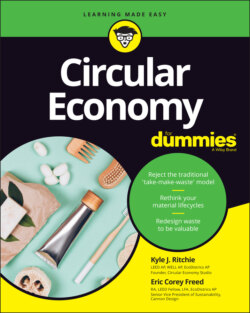Читать книгу Circular Economy For Dummies - Eric Corey Freed - Страница 29
Take, make, and waste
ОглавлениеThe linear way of managing resources is built on the notion that waste is inevitable and acceptable. In this style of resource management, raw materials are taken from the earth and made into products and eventually wind up as waste. These three major milestones of a lifecycle don’t stand isolated from the others, either, but fuel one another.
If waste is an assumed part of a lifecycle, there’s motivation to ensure that the materials that are sourced to make the product are as cheap as possible and the product itself is designed to last only a short amount of time. Keeping costs low also incentivizes the user of those products to dispose of them at the end of their useful life rather than repair them. You wouldn’t try to repair a plastic fork when it breaks. You’d throw it away and go find another one. Using cheap materials and making cheap products fuels the purchase of new products and maintains a consistent supply/demand relationship between manufacturers and customers.
Rethinking material lifecycles can transform the conventional take-make-waste approach toward a new management focused on eliminating waste as a necessity; making long-lasting, resilient products; and regenerating the natural systems on which the human race is dependent.
Rethinking (and improving on) a material lifecycle requires that you identify every element of the cycle. The more details you can identify, the more opportunities you’ll find to improve the lifecycle. First analyze the entire lifecycle, and then find opportunities to conserve resources, increase the efficiency of how those materials are used, and, finally, explore how those materials can be recaptured at the end of their useful life.
